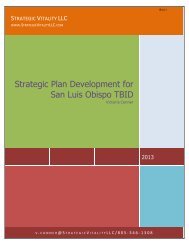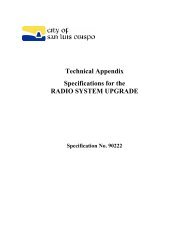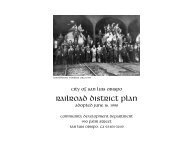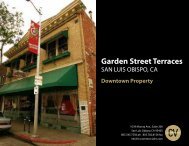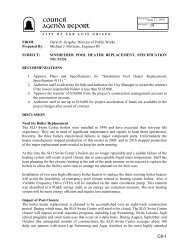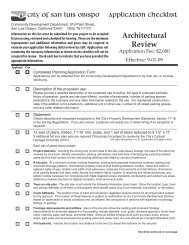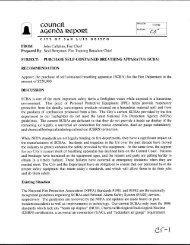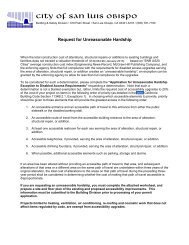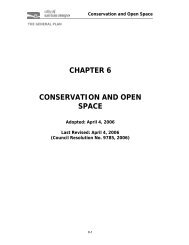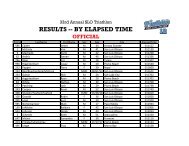Drainage Design Manual - the City of San Luis Obispo
Drainage Design Manual - the City of San Luis Obispo
Drainage Design Manual - the City of San Luis Obispo
You also want an ePaper? Increase the reach of your titles
YUMPU automatically turns print PDFs into web optimized ePapers that Google loves.
Table 4-2. Required Antecedent Moisture FactorsRecurrence Interval (years)Antecedent Moisture Factor(C a )2 to 10 1.025 1.150 1.2100 1.254.1.3 General Procedure for <strong>the</strong> Rational MethodThe general procedure for determining peak discharge at a given concentration point using <strong>the</strong>Rational Method is as follows:Step 1 - Determine <strong>the</strong> drainage area (in hectares).Step 2 - Determine <strong>the</strong> run<strong>of</strong>f coefficient (c) for <strong>the</strong> drainage area, using Table 4-1. If <strong>the</strong>landuse and soil cover are homogeneous for <strong>the</strong> entire drainage area, a single run<strong>of</strong>fcoefficient value can be determine directly from <strong>the</strong> table. If <strong>the</strong>re are multiplelanduses or soil conditions, a weighted average must be calculated as follows:Step 3 - Determine <strong>the</strong> hydraulic length or flow path that will be used to determine <strong>the</strong> time <strong>of</strong>concentration. Also, determine <strong>the</strong> types <strong>of</strong> flow (or flow regimes) that occur along<strong>the</strong> flow path.Step 4 - Determine <strong>the</strong> time <strong>of</strong> concentration (T c ) for <strong>the</strong> drainage area for each subarea andflow path. Add all <strong>of</strong> <strong>the</strong> travel times to get <strong>the</strong> time <strong>of</strong> concentration (T c ) for <strong>the</strong>entire hydraulic length or flow path.Step 5 - Determine <strong>the</strong> Rainfall Intensity Factor (i) for <strong>the</strong> selected design storm by using <strong>the</strong>Rainfall Intensity charts (Tables 4-3 to 4-6). Select <strong>the</strong> chart with average annualrainfall for <strong>the</strong> locality closest to project, as shown on Figure 4-A and 4-B.Step 6- - Determine Antecedent Moisture Factor from Table 4-2 based on <strong>the</strong> design stormbeing considered (i.e. 2- yr, 10-yr, etc)Step 7 - Determine <strong>the</strong> peak discharge according to Equation 4-1.This procedure can be repeated for each concentration point as one moves down a given drainagesystem. At each point, a new T c will need to be completed by adding <strong>the</strong> channel time between<strong>the</strong> previous concentration point and <strong>the</strong> new point to <strong>the</strong> previously estimated T c (per Equation4-6). A new run-<strong>of</strong>f coefficient will be computed pursuant to Equation 4-2, and new rainfallintensity; from Tables 4-3 to 4-6.SLO Creek <strong>Drainage</strong> <strong>Design</strong> <strong>Manual</strong> 28 February 2003



